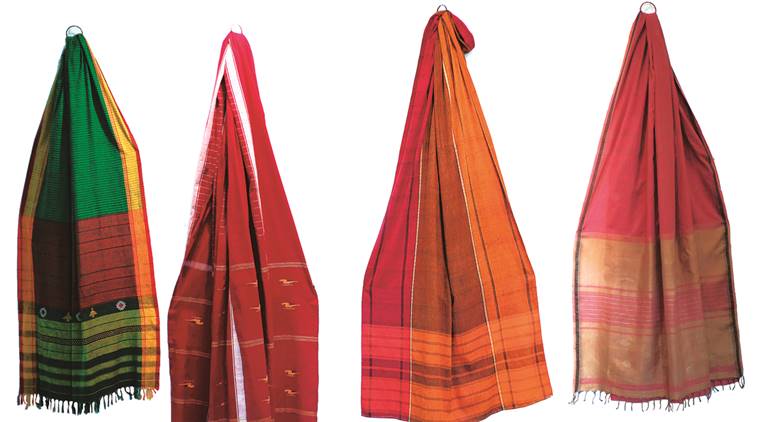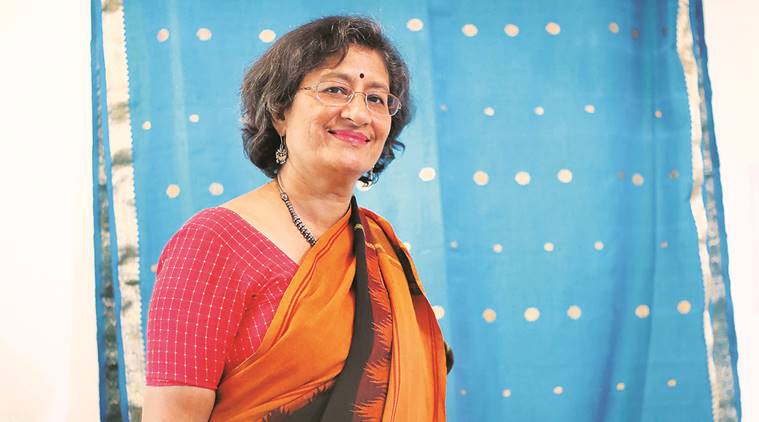 Some of the variety of saris on display at the exhibition (Express photo by Tashi Tobgyal)
Some of the variety of saris on display at the exhibition (Express photo by Tashi Tobgyal)
The strokes within the double muthu (dotted) lines that form perfect squares in the madder red pooja saris, displayed at the exhibition, “The Vimor Saree Story” at Delhi’s India International Centre, typify Vimor’s 45 years of documentation, revival and unflinching support to the weaver community.
A closer assessment reveals a delicate ikkat design, resembling a stroke, at the centre of each square, and the design on the border morphs into a navillukannu (peacock’s eye) while the pallu holds a kalasha motif and birds in the jamdani technique. The original pooja sari is draped on a wall, while an interpretation by Vimor’s co-founder, Pavithra Muddaya, stands on its own at a distance. “In the mid-’70s, when this sari came to us, we did not know where it was woven because neither ikkat nor the jamdani technique were known to be prevalent in Karnataka. But as time went on, and I was able to research, I found out about the saris of the Molkalmuru region of Karnataka that use motifs inspired by nature,” she says, while walking up to her rendition of the original. “We substituted ikkat with thread-work to replicate the hyphens. We maintained the border but changed the bird motif on the pallu a little bit as the weavers were not willing to recreate the design,” she adds.
This is why the pooja sari exemplifies Vimor’s work. It has been a part of its collection since Muddaya’s mother, Chimy Nanjappa, set up the organisation in 1974 after her husband’s passing and holds within its folds intricately woven stories of revival and empowerment. What started with tweaking and mending heritage handloom saris, evolved over the years into a socially conscious store that took care to document textiles, while motivating traditional handloom weavers to continue their craft and sensitising buyers to heritage handloom designs.
 Pavithra Muddaya ((Express photo by Tashi Tobgyal)
Pavithra Muddaya ((Express photo by Tashi Tobgyal)
The Manipuri pallu on display, for instance, was procured for Vimor from a temple auction. “The name stuck because it was evidently woven in Tamil Nadu but the pallu motifs were similar to those from the Northeastern states. The border had the typical rudraksh in three rows. It is quite a piece because it melds the design traditions of two very different states of India. We realised later that the trade route to Cambodia was through the Northeast and that’s where the design influence comes from,” she says.
In another nine yards, the role of the weaver as an archivist of the times gains prominence. It carries motifs of automobiles, bi-planes and gramophones. “A weaver must have travelled to the city and noticed them and decided to incorporate it in his designs. Unfortunately, the weaver, Jayaval, refused to weave more than four saris because his children made fun of him for weaving it despite our assurance of steady orders. He did not want to be the butt of everyone’s jokes. We have just about begun production with the same weaver but it is now done in thread-work instead of zari,” she says.
The care Muddaya takes to uphold her weavers’ interests is best illustrated in the cases of the two master weavers Ranganathan and Govindhan, who despite prospering to “a point where they don’t need to design for Vimor any longer, start their financial year with a bill with us.” This, she gained from her mother, Nanjappa, who “never sent away any weaver who came to her empty-handed and that is the tradition we follow even now. In her own way, instead of entering the organised sector, she saw that weavers who came to her were put on to larger markets. Since, we were supplying to cottage industries, all the weavers who started with us and trained with us, would be put onto our clients. These contacts proved to be big stepping stones for all our weavers,” she says.
To Muddaya, who at the time was juggling an observer traineeship at weaver centres and a law education in Madras, this was bad business sense. “But to my mother, these weavers were our friends and family. They found in her someone they could talk to and as I observed their interactions, I saw that she would talk to them about child marriage, puberty rituals and the need for women in their families to work. She would often ask the wives of these weavers to join them and learn after finishing the household work. She ensured that they were given the utmost respect and then I realised that her success was in their success,” she says, adding without pause, “that is our legacy.”
At IIC in Delhi till July 17